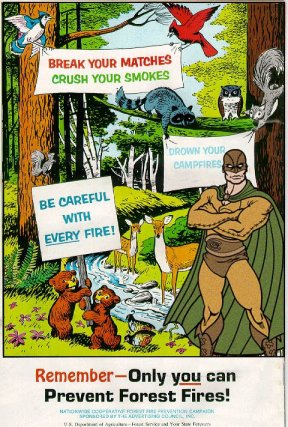|
Commander
Courage:
Proud Symbol of Conservation
When Jackson
Whitney created Commander Courage, the young artist threw
in a lot of his personal obsessions. A dash of patriotism
runs through that classic original run, of course, just like
many comics of the time. Keeping pace with those early stories
is a deep sense of our nation's history, far more accurately
portrayed than most superhero comics of the time, even with
a sensationalized (by modern standards) portrayal of the attack
on Pearl Harbor. That wound was still too fresh, and too little
really known about it at the time.
The one
aspect of Commander Courage's world given short shrift would
turn out to be the thing that set the character apart from
other popular heroes like Captain America, The Shield, and
Superman. From the very beginning of the strip, Jackson tried
to ensure that his hero represented a deep reverence for nature,
just as the Wisconsin autodidact had developed through his
own studies.
Pieces
of it survived editorial suggestion and outright meddling,
as Native American shamans were present at Jefferson Dale's
initial transformation into the buckskinned defender of liberty.
There's some anecdotal evidence that Amazing Comics editor
Delmer McNeal wanted the character's background to be strictly
scientific, better reflecting the superiority of American
know-how. That jingoistic editorial hand would later bedevil
Ken Meehan's Burning Eye strip, which owed a great
debt to Jackson Whitney's original vision.
Though
Jackson took no small pride in the success of Commander Courage,
he privately confided to friends that he wished he could do
more to lead his young readers down the path to what we would
now call conservationism. The occasional nod to Dusty's Eagle
Scout status was not enough.
Sadly,
Jackson would never win the battle with McNeal, abandoning
the strip after eight months to fight a bigger enemy.
Other
writers and artists tried to follow in Jackson's footsteps,
but the results were half-hearted, though certainly entertaining.
At worst, these efforts culminated in characters like the
"Ancient Indian Imp" (Amazing Comics' epithet, not mine) Jinxor,
who called upon the powers of the Great Spirit to meld animals
together in order to cause chaos in general and bedevil Commander
Courage and Liberty Lad in particular.
In a
1955 effort to prove Amazing Comics all-American (long after
All-American Comics itself had been cancelled), McNeal
contacted the USDA Forest Service to offer them the use of
Commander Courage. Yes, in an incredible feat of irony, the
man who had tried to squelch the character's environmental
aspects capitalized upon them to give his company's image
a better coat of paint - bright red, white, and blue with
a touch of forest green.
Foolishly,
in hindsight, McNeal promised in a letter that the Forest
Service could use Commander Courage at no charge for as long
as they liked. Though that offer would later haunt the holders
of Amazing Comics' copyrights, McNeal never saw the results.
At the
time, the venerable government agency rejected the desperate
editor and publisher out of hand. They already had a character,
the stern but loving Smokey Bear.
Originally
created in 1944, Smokey had been literally brought to life
in 1950 when a bear cub was rescued from a devastating forest
fire in the Capitan Mountains of New Mexico. Nicknamed Smokey
by the firefighters who had rescued him, the cub found a home
at the National Zoo in Washington, D.C., where he became so
popular with schoolchildren that Congress passed a law in
order to govern the commercialization of his image. No wonder
the Forest Service had no need of a superhero.
However,
all things must pass, even anthropomorphized animals. When
the "real" Smokey died and was subsequently buried at the
historical park that bears his name in New Mexico, the Forest
Service found itself at a bit of a loss.
It was
1976. The nation had just celebrated its bicentennial, and
perhaps, some in the Forest Service wondered, it was time
for a new image.
For
the rest of the article, click here...
|






